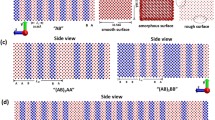Abstract
The inherent low lattice thermal conductivity (TC) of semiconductor nanowires (s-NW) due to one-dimensional phonon confinement might provide a solution for the long-lasting figure-of-merit problem for highly efficient thermoelectric (TE) applications. Standalone diameter modulation or alloying of s-NW serve as a toolkit for TC control, but realizing the full potential of nanowires requires new atomic-scale designs, growth, characterization, and understanding of the physical mechanisms behind the structure–property (TC) relationship. Before undertaking time-consuming and expensive experimental work, molecular dynamics (MD) simulations serve as an excellent probe to investigate new designs and understand how nanostructures affect thermal transport properties through their capability to capture various phenomena such as phonon boundary scattering, phonon coherence resonance, and phonon backscattering. On the other hand, because different research groups use different structural and MD parameters in their simulations, it is rather difficult to make comparisons between different nanostructures and select appropriate ones for potential TE applications. Therefore, in this work, we systematically investigated pristine, core–shell (C–S), holey (H-N), superlattice (SL), sawtooth (ST), and superlattice sawtooth (SL-ST) nanowires with identical structural parameters. Specifically, we aim to compare the relative TC reduction achieved by these nanostructures with respect to pristine nanowires in order to propose the best structural design with the lowest lattice TC, using Green–Kubo method-based equilibrium molecular dynamics simulations at 300 K. Our results show that the TC can be minimized by changing specific parameters such as the core diameter and monolayer separation for C–S, H-N, and ST structures. In the case of SL structures, the TC is found to be independent of these parameters. However, surface roughness in the form of a ST morphology provides a TC value below 2 W/m-K, approaching the amorphous limit.
Similar content being viewed by others
References
F.J. Di Salvo, Science 285, 703 (1999).
L. Liu, N. J. Phys. 16, 123019 (2014).
M.S. Dresselhaus, G. Chen, M.Y. Tang, R. Yang, H. Lee, D. Wang, Z. Ren, J.-P. Fleurial, and P. Gogna, Adv. Mater. 19, 1043 (2007).
G.A. Slack, CRC Handbook of Thermoelectrics, ed. D.M. Rowe and B. Raton (Boca Raton: CRC Press, 1995).
H. Sevincli, C. Sevik, T. Cagin, and G. Cuniberti, Sci. Rep. 3, 5 (2013).
L. Shi, D. Yao, G. Zhang, and B. Li, Appl. Phys. Lett. 95, 063102 (2009).
A.I. Boukai, Y. Bunimovich, J. Tahir-Kheli, J.-K. Yu, W.A. Goddard, and J.R. Heath, Nature 451, 168 (2008).
A.I. Hochbaum, R. Chen, R.D. Delgado, W. Liang, E.C. Garnett, M. Najarian, A. Majumdar, and P. Yang, Nature 451, 163 (2008).
D.Y. Li, Y.Y. Wu, P. Kim, L. Shi, P.D. Yang, and A. Majumdar, Appl. Phys. Lett. 83, 2934 (2003).
D.Y. Li, Y. Wu, R. Fan, P.D. Yang, and A. Majumdar, Appl. Phys. Lett. 83, 3186 (2003).
E.K. Lee, L. Yin, Y. Lee, J.W. Lee, S.J. Lee, J. Lee, S.N. Cha, D. Whang, G.S. Hwang, K. Hippalgaonkar, A. Majumdar, C. Yu, B.L. Choi, J.M. Kim, and K. Kim, Nano Lett 12, 2918 (2012).
L.X. Jun, Z. Ghang, P.Q. Xiang, and Z.Y. Wei, Sci. Chin. Tech. Sci. 57 (2014)
T. Zhang, S.-l. Wu, R.-T. Zheng, and G.-A. Cheng, Nanotechnology 24 (2013).
Y. Li, K. Buddharaju, N. Singh, G.Q. Lo, and S.J. Lee, IEEE Electron Dev. Lett. 32, 674 (2011).
J. Chen, G. Zhang, and B.W. Li, J. Chem. Phys. 135, 8 (2011).
A.L. Moore, S.K. Saha, R.S. Prasher, and L. Shi, Appl. Phys. Lett. 93, 3 (2008).
G. Zhang and Y.-W. Zhang, Phys. Status Solidi Rapid Res. Lett. 7, 754 (2013).
S. Sarikurt, C. Sevik, A. Kinaci, J.B. Haskins, and T. Cagin, Materials Research Society Symposium Proceedings (2015).
S. Plimpton, J. Comput. Phys. 117, 1–19 (1995).
J. Tersoff, Phys. Rev. B 37, 6991 (1988).
J. Tersoff, Phys. Rev. B 39, 5566 (1989).
A. Kinaci, J.B. Haskins, and T. Cagin, J. Chem. Phys. 137, 014106 (2012).
A. Kinaci, J.B. Haskins, C. Sevik, and T. Cagin, Phys. Rev. B 86, 115410 (2012).
C. Sevik, A. Kinaci, J.B. Haskins, and T. Cagin, Phys. Rev. B 86, 075403 (2012).
J.B. Haskins, A. Kinaci, C. Sevik, and T.R. Cagin, J. Chem. Phys. 140 (2014).
J.H. Lee, G.A. Galli, and J.C. Grossman, Nano Lett. 8, 3750 (2008).
J. Tang, H.-T. Wang, D.H. Lee, M. Fardy, Z. Huo, T.P. Russell, and P. Yang, Nano Lett. 10, 4279 (2010).
F. Sansoz, Nano Lett. 11, 5378 (2011).
G. Pernot, M. Stoffel, I. Savic, F. Pezzoli, P. Chen, G. Savelli, A. Jacquot, J. Schumann, U. Denker, I. Moench, O.G. Ch Deneke, J.M. Schmidt, S. Rampnoux, M. Wang, A. Plissonnier, S.Dilhaire Rastelli, and N. Mingo, Nat. Mater. 9, 491 (2010).
M. Hu and D. Poulikakos, Nano Lett. 12, 5487–5494 (2012).
B. Becker, P.K. Schelling, and S.R. Phillpot, J. Appl. Phys. 99, 123715 (2006).
S. Volz, J.B. Saulnier, G. Chen, and P. Beauchamp, Microelectron. J. 31, 815–819 (2000).
K. Hippalgaonkar, R. Chen, B. Budaev, J. Tang, S. Andrews, P. Murphy, S. Mukerjee, J. Moore, and P. Yang, APS March Meeting, March 16–20 (2009)
D.G. Cahill, M. Katiyar, and J.R. Abelson, Phys. Rev. B 50, 6077 (1996).
Author information
Authors and Affiliations
Corresponding author
Rights and permissions
About this article
Cite this article
Özden, A., Kandemir, A., Ay, F. et al. Thermal Conductivity Suppression in Nanostructured Silicon and Germanium Nanowires. J. Electron. Mater. 45, 1594–1600 (2016). https://doi.org/10.1007/s11664-015-4127-4
Received:
Accepted:
Published:
Issue Date:
DOI: https://doi.org/10.1007/s11664-015-4127-4



